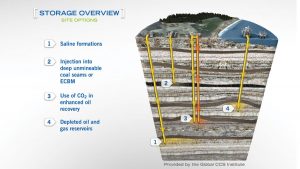ARTICLE 5: CAPROCK LEAKAGE AND SEAL INTEGRITY IN CARBON DIOXIDE STORAGE – PART 1.
The preceding articles in this series explored the key differences between hydrocarbon exploration and CO2 storage. We highlighted the unique properties of supercritical CO2, its flow behaviour in the subsurface, and the critical role of capillary forces in its movement. We discussed advanced techniques for modelling CO2 migration and the importance of understanding the phase transitions and flow physics specific to CO2 storage. These foundational concepts are essential for grasping the complexities of caprock leakage and seal integrity in CO2 storage projects, which is the focus of the next two articles.
The Importance of Caprock Integrity
In CO2 storage, ensuring the integrity of the caprock, the layer of rock overlying the storage formation, is paramount for the long-term viability of a storage site. Quantifying potential pathways for CO2 to escape and the associated leakage rates helps us understand the likelihood of CO2 breaching the caprock and migrating upwards, potentially to ultimately reach the surface (Wilkinson et al., 2006).
Challenges of Evaluating Seal Integrity for CO2 Storage
In the case of oil and gas fields, the long-term integrity of the caprock and sealing faults is often evidenced by the presence of buoyant hydrocarbons trapped below the seal. However, for CO2 storage in saline aquifers, there is often inherent uncertainty about a caprock’s integrity. Unlike hydrocarbon production zones, effective seals for CO2 cannot always be definitively proven before injection. Geologists rely on various data sources to evaluate seal integrity, including core analysis, well logs, seismic data, and an understanding of the geological history of the rock formation, encompassing deposition, diagenetic processes (the physical and chemical alterations rocks undergo over time), and deformation. Additionally, experience with seals in oil and gas fields can provide valuable insights.
Compared to oil and gas operations, there is significantly less experience with the effects of large-scale pressurisation on caprocks used for CO2 storage. Consequently, evaluating seal integrity for CO2 storage sites requires a more detailed and comprehensive approach. In some cases, subsurface data can provide initial evidence of seal integrity for the saline aquifer sites. For instance, pressure data from the Northern Lights Aurora project indicated that the storage formation was at near-hydrostatic conditions, suggesting effective hydraulic separation from the overlying Viking Group, a formation which was depleted due to production from the giant Troll Field (Meneguolo et al., 2021). For more details on how pressure can be used to evaluate top seal see Eleanor Oldham’s blog on pressure plots here.

Capillary Forces and Seal Integrity
The understanding of capillary forces is crucial for assessing caprock leakage and seal integrity. Under capillary-dominated flow conditions, which can be modelled using modified invasion percolation techniques, CO2 either migrates along a path at a low critical saturation (the minimum saturation required for a continuous fluid phase to exist) or backfills and floods a trap at a higher saturation without exceeding the maximum gas saturation for the rock. The capillary threshold pressure is a property determining flow pathways and caprock sealing capacity. This pressure is a function of the interaction of forces within and between the fluids (brine and CO2) and the rock itself. Capillary threshold pressure can be determined in a laboratory setting or derived from permeability values.
In Part 2, we will delve deeper into the role of geomechanics; the study of how fluids influence rock behaviour.
Benjamin Adillah, Senior Reservoir Engineer
References
- Bebb, F. (2021, February). Understanding flow dynamics of CO2 plumes in the subsurface. Subsurface Insights, pp. 21-25.
- Bebb, F. L., Evans, K. C. S., Mukherjee, J., Saeed, B., & Geovani, C. (2021, November). Understanding the flow dynamics of CO2 plumes in the subsurface [Paper presentation]. Abu Dhabi International Petroleum Exhibition & Conference, Abu Dhabi, UAE. https://doi.org/10.2118/207539-MS
- Wilkinson, M., Haszeldine, R. S., & Fallick, A. E. (2006). Hydrocarbon filling and leakage history of a deep geopressured sandstone, Fulmar Formation, United Kingdom North Sea. AAPG Bulletin, 90(12), 1945-1961.
- Meneguolo, R., Kassold, S., Høigjelle, V., & Veselovsky, Z. (2021). Data acquisition and evaluation from the Eos well (31/5-7), Northern Lights CCS project, Norway. [Fourth EAGE Borehole Geology Workshop, September 2021]. https://doi.org/10.3997/2214-4609.2021626019
- Cavanagh, A., & Ringrose, P. (2011). Simulation of CO2 distribution at the In Salah storage site using high-resolution field-scale models. Energy Procedia, 4, 3730-3737.



